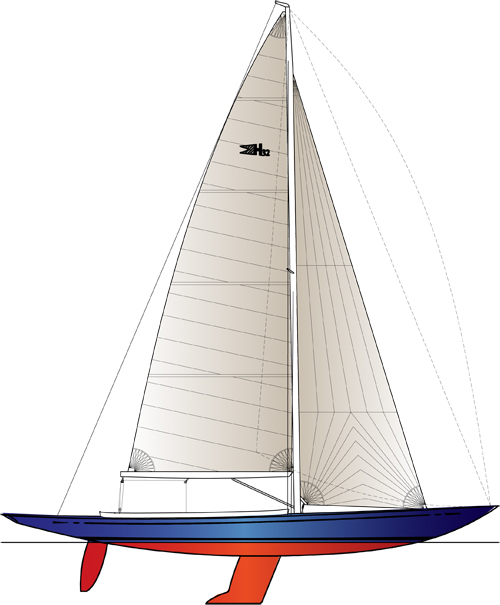CW Hood 32 Daysailer
I was riding my bike home, Hanant to North Beverly, Massachusetts, from work one day many years ago when I decided to detour through Marblehead and visit the Hood yard. As I rode into the parking lot a dark green Jaguar pulled out. Ted Hood was driving. Ted waved at me. That made me happy. I had never met Ted but as I sat there on my bike I thought, "There goes my friend Ted Hood." Years later I met Ted a couple of times at boat shows and he was always very kind to me. Bottom line is I became a fan of anything from the Hood office and that includes this new daysailer. The design credit goes to the two names on the drawings, C. Hood, Ted's nephew, and Ben Stoddard. I had a nice chat with Ben.

While the actual definition of "daysailer" can get a bit murky today this new 32-footer is a true daysailer. This means there are no accommodations at all on this boat. Like an Etchells or a Soling or my old Marblehead favorite, the Hunt 210, this boat is just a hull, a rig and a cockpit. Calls of nature will have to be handled with discretion. There used to be lots of boats like this. You jumped aboard for a fun afternoon of buoy racing and that was that.
It's an unusual hull, combining both classic and modern shape features. The D/L is 154 and the L/B is 4.72, making this a very narrow boat of moderately light displacement. I am lucky in that Ben sent me a full set of hull lines. The entry sections are V-ed but by the midsection the hull goes almost flat at centerline, fairing out aft to almost flat sections at the shapely transom. The BWL is wide for stability and the Cp, or "prismatic coefficient," is .545. Draft is modest at 4 feet with a 12% thickness ratio fin with a flattened bulb tip. The carbon rudder uses a 10% thickness ratio.
The rig is quite traditional in its overall proportions. The fat-head style main is gone in favor of a normal headboard and mainsail. Roach is moderate. The SA/D is 22.82 and that's plenty for this type of design. The mainsheet leads to a barney post in the middle of the cockpit. All other lines lead to a "dashboard" arrangement in the forward face of the cockpit well. There is a bank of cam cleats there with an open bin below to capture all the lines and keep the cockpit clean.
The most interesting feature of the running rigging is the self-tacking jib. The track for the jib car goes almost all the way out to the rail, offering good sheeting angle options. The jib sheet leads forward from the car to enter the deck just aft of the tack point. From there it goes aft under the deck where it attaches to another block. Two control lines from this block allow the jib sheet to be split, with one sheet being led to the bank of cam cleats and the other led aft under the cockpit to come up through the mainsheet barney post. This way the jib sheet is led out aft just below the mainsheet, making it very convenient when sailing short-handed. The mast is carbon and the boom is aluminum. The jib furling unit is below deck.
By the time you read this, the yard will have launched three of these classy looking daysailers. I think white linen pants, a white shirt, club tie and blazer would be the correct outfit to wear while sailing the CW Hood 32. I know I definitely would. You might as well have some fun with it.
LOA 32'3"; LWL 20'; Beam 6'10"; Draft 4'; Displacement 2,750 lbs.; Ballast 1,330 lbs.; Sail area 280 sq. ft.; SA/D 22.82; D/L 154; L/B 4.72
CW Hood Yachts, P.O. Box 443, Marblehead, MA 01945, (781) 631-0192, www.cwhoodyachts.com.
OBE: $96,000
Our Best Estimate of the sailaway price

Comments